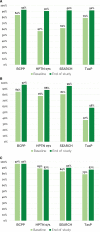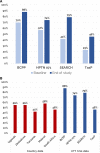What do the Universal Test and Treat trials tell us about the path to HIV epidemic control?
- PMID: 32091179
- PMCID: PMC7038879
- DOI: 10.1002/jia2.25455
What do the Universal Test and Treat trials tell us about the path to HIV epidemic control?
Abstract
Introduction: Achieving HIV epidemic control globally will require new strategies to accelerate reductions in HIV incidence and mortality. Universal test and treat (UTT) was evaluated in four randomized population-based trials (BCPP/Ya Tsie, HPTN 071/PopART, SEARCH, ANRS 12249/TasP) conducted in sub-Saharan Africa (SSA) during expanded antiretroviral treatment (ART) eligibility by World Health Organization guidelines and the UNAIDS 90-90-90 campaign.
Discussion: These three-year studies were conducted in Botswana, Zambia, Uganda, Kenya and South Africa in settings with baseline HIV prevalence from 4% to 30%. Key observations across studies were: (1) Universal testing (implemented via a variety of home and community-based testing approaches) achieved >90% coverage in all studies. (2) When coupled with robust linkage to HIV care, rapid ART start and patient-centred care, UTT achieved among the highest reported population levels of viral suppression in SSA. Significant gains in population-level viral suppression were made in regions with both low and high baseline population viral load; however, viral suppression gains were not uniform across all sub-populations and were lower among youth. (3) UTT resulted in marked reductions in community HIV incidence when universal testing and robust linkage were present. However, HIV elimination targets were not reached. In BCPP and HPTN 071, annualized HIV incidence was approximately 20% to 30% lower in the intervention (which included universal testing) compared to control arms (no universal testing). In SEARCH (where both arms had universal testing), incidence declined 32% over three years. (4) UTT reduced HIV associated mortality by 23% in the intervention versus control communities in SEARCH, a study in which mortality was comprehensively measured.
Conclusions: These trials provide strong evidence that UTT inclusive of universal testing increases population-level viral suppression and decreases HIV incidence and mortality faster than the status quo in SSA and should be adapted at a sub-country level as a public health strategy. However, more is needed, including integration of new prevention interventions into UTT, in order to reach UNAIDS HIV elimination targets.
Keywords: HIV care continuum; HIV elimination; HIV prevention; HIV testing; antiretroviral therapy; public health; universal access.
© 2020 The Authors. Journal of the International AIDS Society published by John Wiley & Sons Ltd on behalf of the International AIDS Society.
Figures


References
-
- Granich RM, Gilks CF, Dye C, De Cock KM, Williams BG. Universal voluntary HIV testing with immediate antiretroviral therapy as a strategy for elimination of HIV transmission: a mathematical model. Lancet. 2009;373(9657):48–57. - PubMed
Publication types
MeSH terms
Substances
Grants and funding
LinkOut - more resources
Full Text Sources
Medical
Research Materials
Miscellaneous

